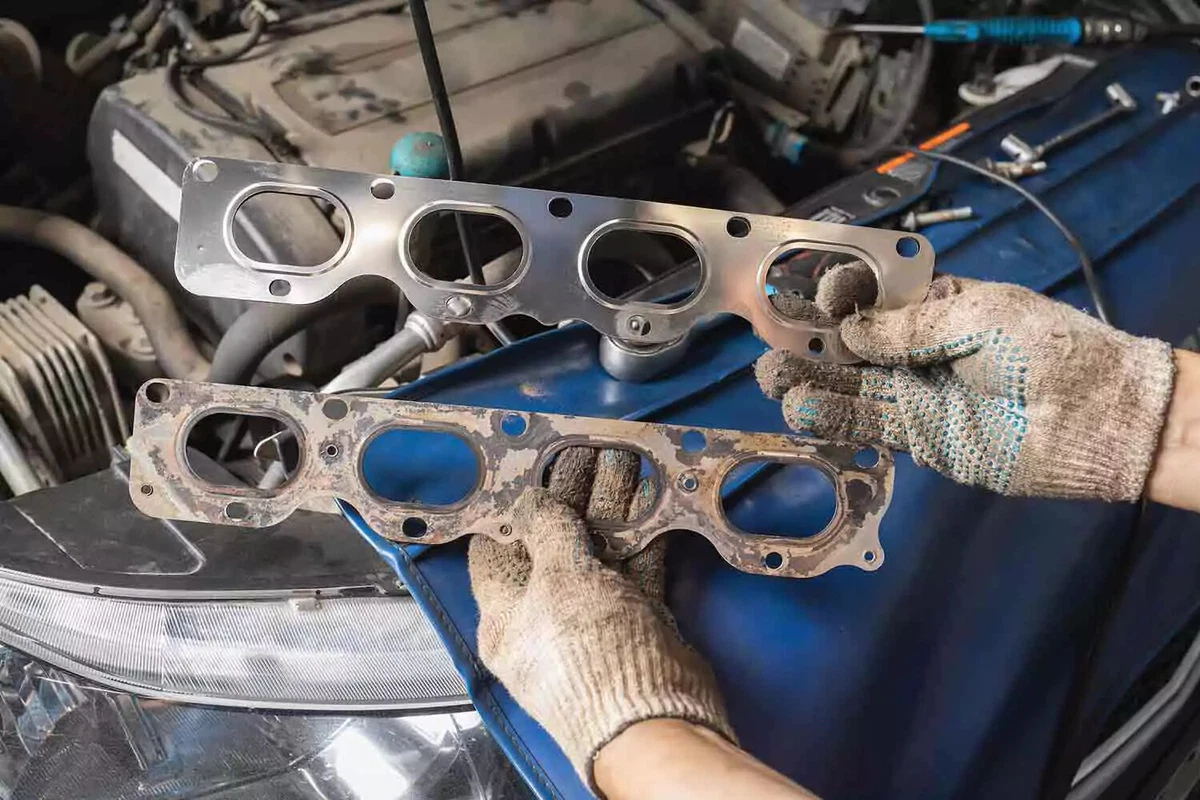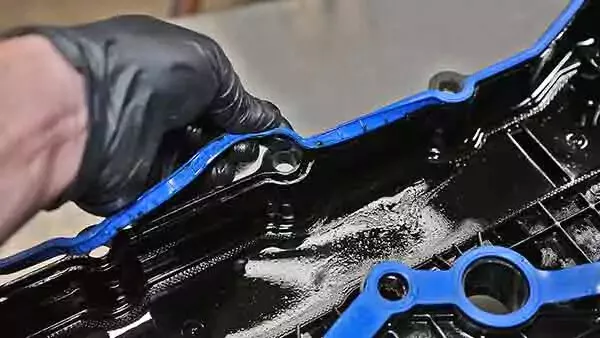Excessive heat, corrosion, and old age can cause exhaust gasket failure. Figuring out the cause of the exhaust leak is the first step to finding the best parts for a successful repair.
The same things that make engines susceptible to exhaust leaks make them more challenging to repair. Engines with exhaust manifolds wedged in close to the firewall can run hotter, making it a challenge to get a wrench on the bolts. The same holds true on twin-turbocharged V-6 engines. Longer exhaust manifolds on inline six-cylinder engines are also prone to warping.
Exhaust Manifold Gaskets Come in Different Materials

A mechanic comparing a new steel exhaust manifold gasket with the old gasket that it will replace.
The manifold gasket isn't the only one in the exhaust system. There are header, collector, or flange gaskets that seal the manifold to the exhaust pipe or catalytic converter. Some exhaust flange gaskets are known as donuts. The rounded shape prevents leaks and allows movement between the exhaust manifold and pipe.
Gasket materials vary by engine and manufacturer.
Composite: This catch-all category includes exhaust gaskets with a blend of different materials. Graphite and compressed fiber are the most common types. Laminating graphite or carbon composites with layers of metal or copper adds corrosion resistance and durability.
Multi-layered steel (MLS): Exhaust gaskets with multiple thin layers of carbon or stainless spring steel provide superior sealing and longevity over compressed fiber or graphite composites. Adding a molybdenum disulfide coating increases heat and corrosion resistance. It’s a nice upgrade to your engine.
Copper: Embossed copper exhaust gaskets are used primarily for high-performance and racing engines. The dead soft copper conforms to various metal mating surfaces and maintains a tight seal in extremely high heat conditions created by sustained boost and exotic fuels. It’s not needed for a commuter vehicle.
How much does an exhaust manifold gasket cost?
Compressed fiber gaskets are the least expensive and durable. A high-quality example runs between $20 and $30. If your vehicle is old, it could be even less. Prices increase for composite gaskets. MLS and copper varieties stand at the top of the price and durability scale. Any exhaust manifold gasket is comparatively cheap, but a gasket alone is rarely all you'll need to fix an exhaust leak.
Getting to the exhaust manifold gasket often means removing everything around it. Heat shields, manifold, and flange bolts, and brackets rarely survive the removal process, and a cracked or warped exhaust manifold is scrap metal. Some exhaust manifolds and catalytic converters are sold as a unit. Buying an exhaust manifold kit with heat shields, hardware, and gaskets can save money and time. This could add another $100 or $200 to your order.
High-Performance Exhaust Manifold Gaskets

Embossed copper header gaskets get the nod for high-performance applications.
Back in the analog days of breaker points ignitions, carburetors, and 30-cent-per-gallon gasoline, swapping out the restrictive factory air cleaner, wheezy single-throat carburetor, and crusty cast iron manifolds for an open-element air filter, four-barrel carburetor, and steel tube exhaust headers could unleash untapped horsepower. Even if it didn't make your car go any faster, it sure felt and sounded like it did.
Extracting hidden horsepower from a modern engine with electronic fuel injection is more complex than bolting up a set of headers. Many of today's engines are factory-equipped with steel tube header exhaust manifolds, just like hopped-up Plymouth Dusters back in the day. The gasket that came with your vehicle as it left the factory is probably all you may ever need. High-performance exhaust manifolds, headers, and gaskets are options, but only consider them if the stockers are shot.
Parts Related to Exhaust Manifold Gasket Replacement

Whether it’s rocker panels, floor boards, or exhaust manifolds, rust never sleeps.
Exhaust and emissions systems are closely intertwined. Inspect the EGR exhaust gas recirculation valve gaskets and oxygen sensor bung for leaks. An intake manifold or PCV valve intake vacuum leak can cause a lean fuel-air mixture, overheated exhaust, and damaged gaskets. See the relevant DIY step-by-step videos and guides.
Do you notice any old or brittle plastic parts around your engine? Consider a few backup replacements for old or brittle plastic parts that could break or crumble into dust on the way to the exhaust manifold. Replace broken or crusty ground straps. These can wreak havoc on modern electronically controlled automotive systems. Dropping or fumbling a cast iron or steel exhaust manifold can break spark plugs. You might want to order a new set. At worst, you’ll have spares for the next scheduled change.
Related Tools and Accessories

For a proper seal, remove the old gasket residue from an engine before installing a new exhaust manifold gasket.
A basic set of automotive hand tools—including sockets, swivels, and extensions—should be enough for most exhaust manifold gasket work. Penetrating oil can loosen stubborn bolts, and a carbide scraper makes short work of caked-on carbon and old gasket material. Thread chasers can save slightly stripped bolts. A tap-and-die kit is a lifesaver if you find yourself working on an old and crusty vehicle. Trim and clip pliers or trim removal tools are handy for removing plastic covers and parts without breaking the fasteners.
If road salt is part of your seasonal driving experience and your exhaust manifold and flange bolts look like the rivets on an undersea shipwreck, then add these things to your shopping list: an oxy-acetylene or MAP gas torch, induction coil bolt heater, bolt extractors, easy outs, left-handed drill bits, and a set of thread inserts.
If you don’t have one, consider getting an impact wrench. The hammering action of electric or pneumatic impact wrenches can help loosen corroded bolts.
Finally, replacing the exhaust manifold gasket means reinstalling your exhaust manifold. Always use a torque wrench to cinch everything back together.
Broken or missing exhaust manifold bolts are a common cause of exhaust leaks. Manifold bolt repair brackets or clamp kits promise to fix the tick without removing broken bolts, exhaust manifolds, or gaskets. A bolt-in-place bracket forms a bridge over the manifold. Tightening a bolt in the bridge cinches down the manifold on the cylinder head to seal the leak.
Share your feedback
This article is meant to provide general guidance only. Automotive maintenance, repair, upgrade, and installation may depend on vehicle-specifics such as make and model. Always consult your owner's manual, repair guide for specific information for your particular vehicle and consider a licensed auto-care professional's help as well, particularly for advance repairs.





























































